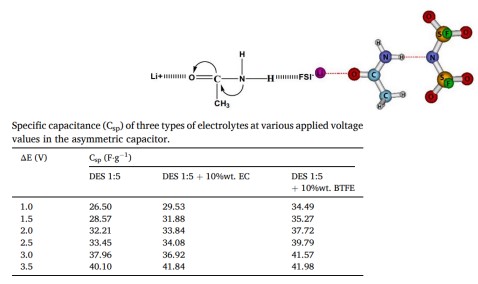Pasit Pakawatpanurut
Renewable energy has become the forefront issue for much of the economic and social development. However, renewable energy sources are intermittent in nature, which is a drawback that must be addressed by using energy storage systems to enable full potential of renewable energy. Supercapacitors and batteries offer viable solutions to help balance energy demand and production capacity. This work reported a significant improvement in terms of potential window and electrochemical and thermal stability of supercapacitors by introducing a new electrolyte system based on lithium bis(fluorosulfonyl)imide (LiFSI) and acetamide. When assembled into a device of the type electrical double layer capacitor, this electrolyte yielded a capacitance of 23 F/g (at 1 A/g) at 3.0 V and retained about 99.0% of initial capacitance after 1,000 cycles. In addition, when assembled into an asymmetric device using MnO2 as a positive electrode and activated carbon as a negative electrode, the device could be reversibly cycled in a wide potential window of 0–3.0 V with an energy density of 74.79 Wh/kg and a retention of 68.3% after 2,000 cycles. Such contributions are consistent with the affordable/clean energy and the climate action SDG goals.

Reference: “Novel deep eutectic solvent-based on lithium bis(fluorosulfonyl)imide and acetamide as high-performance electrolytes for 3.0 V asymmetric supercapacitor” Truong, T.T.T.; Le, L.T.M.; Nguyen, H.V.; Nguyen, Q.D.; Tran, M.V.; Phung, Q.; Pakawatpanurut, P.; Nguyen, A.T.; Nguyen, T.T.; Garg, A.; Le, P.M.L. Journal of Energy Storage 2022, 53, 105088.
